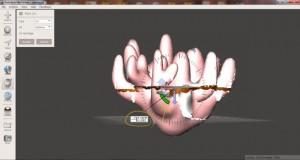 Not once have I ever even considered how rock candy is made, conventionally. As 3D experimentation goes, though, rock candy is a perfect medium with which to work. It’s basically a simple—and fun—science project. Aaron Porterfield took his craving for sweets to the high-tech arena with a basic sugar water recipe, a free app, a 3D printer, a dash of patience, and some enthusiasm for 3D printing experimentation.
Not once have I ever even considered how rock candy is made, conventionally. As 3D experimentation goes, though, rock candy is a perfect medium with which to work. It’s basically a simple—and fun—science project. Aaron Porterfield took his craving for sweets to the high-tech arena with a basic sugar water recipe, a free app, a 3D printer, a dash of patience, and some enthusiasm for 3D printing experimentation.
This is a modern spin on a very old, basic confectionary science, as rock candy originated in Iran in the 9th century. To speed up sugar crystallization, confectioners experimented and learned to immerse twigs for the crystals to grow on in the sugar solution. Here, Aaron is basically creating his own high-tech “twig” or surface for the crystals to grow on, in the form of a 3D printed surface. To find out more about the sugar recipe he used, see this recipe.
Aaron used a powerful free app called Autodesk Meshmixer (downloaded from meshmixer.com) to sculpt the vehicles on which he wanted the rock candy to grow. Beginning with a sphere, he began to create and mold his structure for the candy.
The sculpting app provides a brush tool that Aaron used to “grow” the spikes. The user can play with the model adding all sorts of different variations to the spikes and creating various shapes, but he advised not to create steep overhangs or anything too difficult at first while experimenting, as this would make the 3D printing process a challenge.
After sculpting the structure, a flat surface was needed for the bottom of the structure, so he used the app to slice a clean flat resting area for the piece. Once printed, all Aaron needed was some of the sugar syrup concoction to start  growing. Immersing the structure in a container full of the sugar water, he waited several days until he could see that crystallization was happening, and he took the structure out to look at, advising that other users will probably have better results if they wait longer.
growing. Immersing the structure in a container full of the sugar water, he waited several days until he could see that crystallization was happening, and he took the structure out to look at, advising that other users will probably have better results if they wait longer.
Rock candy is a simple sugar candy that can double as a fun science experiment. The process can take up to a week, but it’s fun to watch the sugar crystals growing over time. The key is that you need surfaces for the rock candy to grow, and what a better experiment to attempt with 3D printing, bringing new science to the old, tried and true science of rock candy making.
Aaron Porterfield, a member of Instructables.com, has also worked on 3D printing projects like “How to Design 3Dprinted Glasses.” To find out more about his creations, click here. Discuss this project in further detail in the 3D printed rock candy forum thread on 3DPB.com
Subscribe to Our Email Newsletter
Stay up-to-date on all the latest news from the 3D printing industry and receive information and offers from third party vendors.
You May Also Like
Kings 3D Introduces Five New 3D Printers Ahead of TCT Asia
In the weeks leading up to TCT Asia, the 3D printing scene in China is already bustling with activity and product promotion. Among the companies taking part is stereolithography (SLA)...
3D Printing Webinar and Event Roundup: April 28, 2024
In this week’s 3D Printing Webinar and Event Roundup, the Ceramics Expo is taking place in Michigan, Stratasys continues its advanced training courses, and SPE is holding a Polymer Characterization...
3D Printing Webinar and Event Roundup: April 21, 2024
It’s another busy week of webinars and events, starting with Hannover Messe in Germany and continuing with Metalcasting Congress, Chinaplas, TechBlick’s Innovation Festival, and more. Stratasys continues its advanced training...
Latest Earnings Overview for Australian 3D Printing Firms Titomic and AML3D
Australian 3D printing manufacturing firms Titomic (ASX: TTT) and AML3D (ASX: AL3) reported their financial results for the period from July to December 2023, marking the first half of their...































